Novel approaches to deepwater steel catenary production riser life extension benefit ESG
Since they were first installed on Shell's Auger platform in 1994, deepwater steel catenary production risers (SCRs) have been an integral part of offshore oil and gas production facilities. In nearly three decades, hundreds of SCRs have been deployed throughout the industry, as they have proved to be cost-effective and highly reliable.
After long periods of operations, many SCRs are now close to, or have exceeded, their certified service lives. The harsh and dynamic deepwater environment has subjected these risers to long-term fatigue loading accumulation, with the region around the touchdown point (TDP), where the SCR meets the seabed, often the critical area limiting any fatigue life remaining.
However, despite this challenge, operators have a desire to continue to operate their SCRs reliably beyond their original planned service life, to maximize production and return on investment. Therefore, there is a growing interest in life extension strategies for SCRs.
ESG benefit to extend operational life. Extending the operational life of deepwater SCRs not only offers a cost-effective opportunity to increase production, but also aligns with the principles of environmental, social, and governance (ESG) practices, Fig 1. While it is true that all CO2 emissions could be avoided by transitioning to renewable energy sources and eliminating oil and gas production, the reality is that the world is still heavily dependent on hydrocarbons to meet its energy needs.
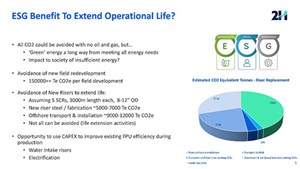
Insufficient energy supply has a significant impact on society, therefore continued use of existing energy infrastructure to secure this supply becomes crucial. Extending the life of SCRs enables operators to avoid new field redevelopment, which avoids substantial additional CO2 emissions. A typical field development project can generate over 150,000 metric tons of CO2 equivalent emissions.
Further, by avoiding the need for new risers, operators also can significantly reduce the carbon footprint associated with the fabrication, transportation and installation of these. Assuming the installation of five typical SCRs, each with a length of 3,000 m and an outer diameter of 8 in. to 12 in., the production of new riser steel and fabrication alone would result in approximately 5,000 to 7,000 metric tons of CO2-equivalent emissions. The offshore transport and installation of these risers would further contribute approximately 9,000 to 12,000 metric tons of CO2-equivalent emissions.
While it is not possible to completely eliminate CO2 emissions associated with life extension activities, the opportunity exists to use capital expenditures (CAPEX) elsewhere to improve the efficiency of the existing FPU during production. This can be achieved through initiatives, such as optimizing water intake risers and electrification, reducing the overall environmental impact of the operation.
Concepts to extend life. The challenge is how to extend life when minimal fatigue life remains at the touchdown region, and the riser is beyond the certified design life?
The strategy pioneered by 2H is to apply one or more of a range of measures to relocate the touchdown point. The location of the original touch down point (green line in Fig. 2.), with high fatigue damage accrual, must see minimal further fatigue damage accrued over the required service life extension (typically 10-20 years). The new touchdown point location (light blue line in Fig. 2.) must have minimal fatigue damage already accrued, since the SCR was originally installed, so that there is sufficient fatigue capacity remaining to accommodate the higher fatigue damage rate at this location.
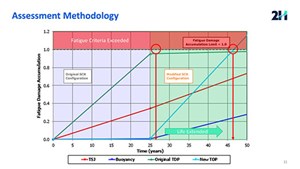
There is a number of ways to relocate the touchdown point, which all involve changing the shape of the SCR. This may be achieved through one or a combination of the following concepts:
- Relocating the floating production platform
- Changing the length of the riser by adding or removing riser joints
- Adding buoyancy modules to the riser.
However, are these concepts all suitable?
Relocating the floating production platform is an approach, which is already used to extend the service life of risers for challenging fields, with examples operating in the Gulf of Mexico. In these cases, the platform is planned to be relocated three or more times to provide required service life, as shown in Fig. 3. However, these facilities have the capability built into the mooring system prior to installation in the field. To retrospectively install this capability to a production platform is highly complex, costly, and given the very high construction vessel time, has emissions higher than the initial installation. It is, therefore, not considered a viable concept, based on practicality and ESG.
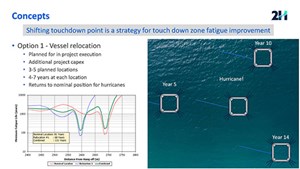
The concept to change the length of the SCR typically requires one or two joints to be removed to achieve the extended service life requirement. This is a complex operation, due to the need to transfer the SCR from the floating production platform to a construction vessel, and then cut and re-weld the riser. These operations are, however, similar to operations that are undertaken offshore to inspect and maintain SCRs to involve proven offshore operations. Indeed, where the joint removal operation can be conducted alongside regular inspection operations, this may minimize the additional construction vessel time. Even with the use of a construction vessel, good ESG benefit comes from this concept, compared to a full field development, but, given the complex operations, other concepts may be preferred.
The final concept is to add buoyancy modules, Fig. 4. This is the preferred concept from a cost, risk and ESG standpoint. This approach utilizes existing technology to retrofit buoyancy modules to a subsea riser, using an ROV. This concept also minimizes emissions, as the operations require a much smaller vessel, compared to the other concepts. However, as installing buoyancy modules subsea with an ROV takes time, this can be a time-consuming operation; installing high numbers of buoyancy erodes the ESG benefit. Typically, 10 to 20 buoyancy modules are required per riser to achieve the required service life extension. Therefore, the ESG benefit is high.
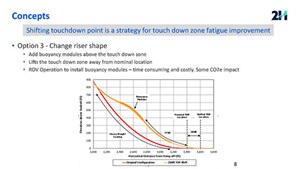
Assessment approach. An iterative process is utilized to establish the optimal solution, which achieves the service life extension required and optimizes the cost and the ESG benefits. The approach starts by considering whether the benefits can be achieved with the addition of buoyancy modules to maximize the ESG benefit. It also considers the removal of joints, if too many additional buoyancy modules are required.
The assessment process is as shown in Fig. 5 and involves:
- Identifying the number of extra buoyancy modules and riser joints removed to shift the TDP location by the required amount
- Confirming whether the fatigue and strength requirements of the riser for extended service life are met
- Estimating the cost and emissions
- Iterating until an acceptable or optimized solution is achieved.
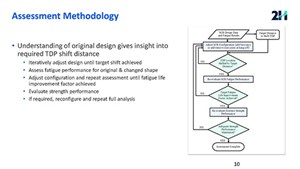
Conclusion. A range of approaches to extend service live of SCRs is established. The extension of the operational life of deepwater SCRs offers significant benefits in terms of increased production, cost-effectiveness and alignment with ESG principles. By avoiding new field redevelopment and the need for new risers, operators can remove the carbon footprint associated with new oil and gas project development, and capital expenditure can be used to improve the efficiency of existing infrastructure, further reducing the environmental impact. Of these options, addition of buoyancy is the most favorable, but achieving adequate service life may also require the removal of riser joints, limiting the overall ESG benefit.
- Advancing offshore decarbonization through electrification of FPSOs (March 2024)
- The last barrel (February 2024)
- Oil and gas in the Capitals (February 2024)
- What's new in production (February 2024)
- First oil (February 2024)
- Subsea technology- Corrosion monitoring: From failure to success (February 2024)
- Applying ultra-deep LWD resistivity technology successfully in a SAGD operation (May 2019)
- Adoption of wireless intelligent completions advances (May 2019)
- Majors double down as takeaway crunch eases (April 2019)
- What’s new in well logging and formation evaluation (April 2019)
- Qualification of a 20,000-psi subsea BOP: A collaborative approach (February 2019)
- ConocoPhillips’ Greg Leveille sees rapid trajectory of technical advancement continuing (February 2019)


